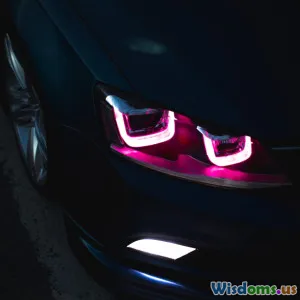
Can Augmented Reality Dashboards Prevent Highway Collisions
9 min read Explore how augmented reality dashboards can enhance driver awareness and reduce highway collisions through innovative visualization technologies. (0 Reviews)
Can Augmented Reality Dashboards Prevent Highway Collisions?
Highway driving demands constant vigilance—a task that human drivers are often far from perfect at. According to the National Highway Traffic Safety Administration (NHTSA), approximately 37,000 people die annually on U.S. roads, many in collisions that could have been prevented with better awareness. In recent years, automotive technology has steadily advanced to assist drivers, but an emerging innovation stands out for its transformative potential: augmented reality (AR) dashboards. By seamlessly integrating critical information into the driver’s view, AR dashboards offer a new frontier in collision prevention.
This article explores how AR dashboards work, their benefits in preventing highway collisions, real-world examples, the challenges and limitations, and a future outlook on this promising technology.
Understanding Augmented Reality Dashboards
Augmented Reality dashboards incorporate digital information, such as navigation cues, hazard warnings, and vehicle status, directly onto the windshield or an overlay screen. Unlike traditional dashboards that require drivers to look away from the road, AR systems superimpose graphics within the driver’s line of sight.
How AR Dashboards Work
Typically, AR dashboards use a combination of sensors, cameras, and sophisticated software algorithms to analyze the vehicle’s environment in real-time. This data is visualized as:
- Heads-Up Display (HUD): Projects navigation and status data onto the windshield.
- 3D Visualization: Highlights lane boundaries, nearby vehicles, obstacles, and potential hazards.
- Adaptive Alerts: Uses auditory and visual cues that respond contextually to danger.
For instance, the Honda Legend Hybrid EX introduced a HUD projecting lane departure warnings and collision risk alerts within the driver’s sight. Similarly, Bosch’s “AR-enabled HUD” system displays green guide lines to help drivers maintain safe lane positions.
The Role of AR Dashboards in Preventing Highway Collisions
Enhancing Situational Awareness
One leading cause of car accidents is driver distraction or delayed reactions. Looking down at instrument panels or glancing at smartphones disrupts a driver's focus. AR dashboards eliminate this distraction by providing information directly in the driving line of sight.
A 2021 study by the University of Michigan Transportation Research Institute indicated that AR HUDs reduce the frequency of drivers looking away from the road by up to 75%, leading to faster responses to abrupt highway hazards like sudden braking or obstacles.
Real-Time Hazard Identification
AR dashboards equipped with advanced sensor arrays can identify risks earlier than unaided vision. For example, if a pedestrian steps onto the highway shoulder or an erratic vehicle approaches, the AR system highlights the threat with vivid graphics—such as a flashing red outline or directional arrow—giving the driver more time to react.
Tesla and Waymo are investing heavily in HUD and AR optics integrated with their autonomous systems to provide these real-time hazard alerts during semi-autonomous driving modes.
Navigation and Lane Keeping Improvements
Complex highway interchanges and multi-lane highways require clear and intuitive navigation aids. GPS alone can be confusing, especially at high speeds or poor-visibility conditions.
By projecting 3D arrows and lane guidance directly onto the windshield, AR dashboards help drivers anticipate lane changes, exit ramps, or upcoming obstacles. Audi’s Virtual Cockpit Plus system is an example—it displays both 2D and 3D supplementations, improving driver decision-making and decreasing erratic driving maneuvers that often cause collisions.
Reducing Fatigue and Cognitive Load
Highway driving is often monotonous but requires continuous attention. Traditional HUDs and dashboards add to cognitive load by forcing drivers to mentally map abstract data onto the roadway scene.
Augmented reality's direct visual overlays reduce cognitive effort. By naturally integrating warnings and alerts into the real world, the driver interprets and acts upon information faster. This benefit was underscored in a 2022 experiment performed by the Fraunhofer Institute, revealing 20% fewer missed hazard cues and a significant drop in driving errors when AR dashboards were employed.
Real-World Applications and Success Stories
Automotive Industry Initiatives
- Hyundai and Kia: Utilizing AR dashboards in concept vehicles with transparent lenses displaying hazard warnings, navigation, and speed limits, enhancing driver immersion.
- BMW iNext Project: Integrates AR HUDs to assist with overtaking and highway driving by projecting vehicle trajectories and warnings about nearby cars.
Additional players like WayRay and Luminar are advancing AR display technologies to facilitate mass adoption in new vehicles.
Emergency and Commercial Vehicles
Augmented reality dashboards are also being tested in emergency response and freight trucking. By improving situational awareness, firefighters experience safer navigation through chaotic highway scenes, while truck drivers benefit from early hazard warnings that help mitigate severe multi-vehicle wreck incidents common on highways.
Simulation and Training
Beyond direct collision prevention, AR dashboards support driver training. Simulators using AR provide realistic hazard scenarios aiding drivers to better anticipate and respond to highway dangers.
Challenges to Widespread Adoption
Despite the promise, several barriers remain:
Technical Limitations
- Display Clarity: Ensuring visualization is intuitive yet non-distracting under various lighting conditions.
- Sensor Accuracy: Real-time environmental mapping relies on precise sensors, which can be compromised by weather or road debris.
Cost and Manufacturing Complexity
Incorporating AR systems adds production costs, limiting accessibility in budget vehicles.
Driver Dependence and Habituation
Experts warn about over-reliance on AR warnings leading to reduced active vigilance. Balancing assistance with maintaining driver engagement is vital.
Regulatory and Standardization Issues
Governments will need to establish safety standards for AR display brightness, content, and alert types to prevent information overload or confusion.
The Future of AR Dashboards in Highway Safety
Advancements in AI and 5G connectivity promise even smarter AR dashboards. Integration with V2X (vehicle-to-everything) communication systems could allow AR systems to display hazard warnings even before they enter the driver’s immediate sensor range, dramatically extending reaction time.
Moreover, as fully autonomous vehicles mature, AR dashboards might shift roles from hazard prevention to passenger information and entertainment in highway scenarios.
Conclusion
Augmented reality dashboards are not just a futuristic novelty—they are rapidly becoming essential tools that could fundamentally shift how drivers perceive and respond to highway hazards. By enhancing situational awareness, streamlining information delivery, and enabling faster, safer decision-making, AR dashboards offer tangible pathways to reduce collisions. Real-world implementations and studies underscore their efficacy, though challenges around technology, cost, and regulation must be addressed.
What remains indisputable is this: seamlessly blending the digital world with the physical highway environment empowers drivers to navigate more safely. As AR dashboard technology evolves, it is poised to become a standard safety feature, preventing collisions and saving lives on our highways.
References:
- National Highway Traffic Safety Administration, 2023 Traffic Safety Facts
- University of Michigan Transportation Research Institute, 2021 HUD Study
- Fraunhofer Institute for Industrial Engineering, 2022 AR Driving Experiment
- Automotive Manufacturer Press Releases (BMW, Hyundai, Audi)
- Bosch AR HUD Technology Overview
Rate the Post
User Reviews
Other posts in Augmented Reality Dashboards
Popular Posts
















